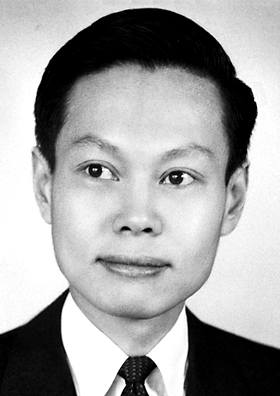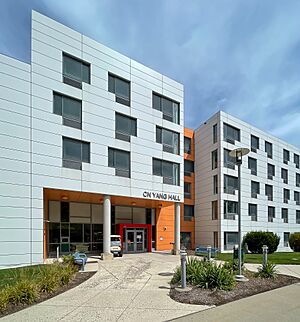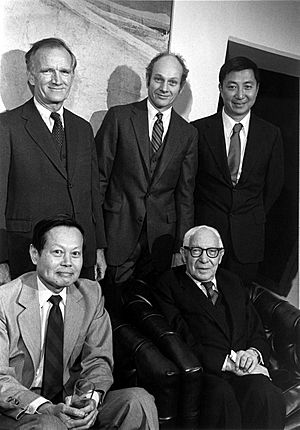Yang Chen-Ning facts for kids
Quick facts for kids
Yang Chen-Ning
|
|||||||||||
|---|---|---|---|---|---|---|---|---|---|---|---|
| 楊振寧 | |||||||||||

Yang in 1957
|
|||||||||||
| Born |
Yang Chen-Ning (楊振寧)
1 October 1922 |
||||||||||
| Citizenship |
|
||||||||||
| Alma mater |
|
||||||||||
| Known for |
List
Yang–Baxter equation
Yang-Baxter operator Yang–Mills theory Byers-Yang theorem Landau–Yang theorem Lee–Yang theorem Lee–Yang theory Wu–Yang dictionary Wu–Yang monopole Fermi–Yang model Off-diagonal long-range order G-parity Parity violation |
||||||||||
| Spouse(s) |
|
||||||||||
| Children | 3 | ||||||||||
| Awards |
List
Nobel Prize in Physics (1957)
Guggenheim Fellowship (1962) Fritz London Memorial Lecture (1966) Rumford Prize (1980) National Medal of Science (1986) Oskar Klein Memorial Lecture (1988) ForMemRS (1992) Benjamin Franklin Medal (1993) Bower Award (1994) Albert Einstein Medal (1995) Bogolyubov Prize (1996) Lars Onsager Prize (1999) King Faisal Prize (2001) |
||||||||||
| Scientific career | |||||||||||
| Fields | |||||||||||
| Institutions |
|
||||||||||
| Doctoral advisor | Edward Teller | ||||||||||
| Other academic advisors | Enrico Fermi | ||||||||||
| Doctoral students |
|
||||||||||
| Chinese name | |||||||||||
| Simplified Chinese | 杨振宁 | ||||||||||
| Traditional Chinese | 楊振寧 | ||||||||||
|
|||||||||||
| Signature | |||||||||||
 |
|||||||||||
Yang Chen-Ning (born 1 October 1922), also known as C. N. Yang, is a Chinese theoretical physicist. He has made very important discoveries in areas like statistical mechanics and particle physics.
In 1957, he and Tsung-Dao Lee won the Nobel Prize in Physics. They discovered that a basic rule of physics, called parity conservation, is not always true. This was a big surprise in the world of physics! Yang is also famous for creating the Yang–Mills theory with Robert Mills. This theory helps us understand how tiny particles interact. Yang Chen-Ning celebrated his 100th birthday in September 2022.
Contents
Early Life and Education
Yang was born in Hefei, China. His father was a mathematician, and his mother was a homemaker.
He went to school in Beijing. In 1937, his family moved to Hefei because of the war. Then, in 1938, they moved to Kunming. There, Yang studied at National Southwestern Associated University. He earned his first degree in 1942. His thesis was about how group theory applies to molecules.
Yang continued his studies, focusing on statistical mechanics. In 1944, he received his master's degree from Tsinghua University. He then got a scholarship to study in the United States. Before leaving, he taught at a middle school for a year.
In January 1946, Yang started studying at the University of Chicago. He earned his PhD in 1948.
A Career in Physics
After getting his PhD, Yang worked at the University of Chicago for a year. In 1949, he joined the Institute for Advanced Study in Princeton, New Jersey. There, he worked closely with Tsung-Dao Lee. He became a full professor in 1955.
In 1965, he moved to Stony Brook University. He became the first director of the Institute for Theoretical Physics there. This institute is now named the C. N. Yang Institute for Theoretical Physics in his honor.
Yang retired from Stony Brook University in 1999. In 2010, a new dormitory building at Stony Brook was named C. N. Yang Hall.
Yang has been recognized by many important science groups. These include the American Physical Society and the Chinese Academy of Sciences. He has also received honorary degrees from universities like Princeton University.
In 1971, Yang visited mainland China for the first time in many years. He helped Chinese scientists rebuild their research after a difficult period. After retiring from Stony Brook, he became an honorary director at Tsinghua University in Beijing. He also works as a professor at the Chinese University of Hong Kong.
Yang helped create the Theoretical Physics Division at the Chern Institute of Mathematics in 1986. He also became the first president of the Association of Asia Pacific Physical Societies (AAPPS) in 1989. In 1997, the AAPPS created the C.N. Yang Award to celebrate young researchers.
Personal Life
Yang married Tu Chih-li in 1950. She was a teacher. They had two sons and one daughter. Tu Chih-li passed away in 2003.
In 2005, Yang married Weng Fan. They had met earlier at a physics seminar. Yang gave up his U.S. citizenship in 2015.
On October 1, 2022, Yang turned 100 years old.
Major Discoveries in Physics
Yang has worked on many areas of physics. These include statistical mechanics, condensed matter theory, and particle physics.
At the University of Chicago, Yang first tried working in an accelerator lab. But he realized he was better at theoretical physics. His PhD work was about how particles move in nuclear reactions.
The Yang–Mills Theory
Yang is very famous for his work with Robert Mills in 1953. They developed the Yang–Mills theory. This theory is a key part of how we understand the forces between tiny subatomic particles. It has changed modern physics and mathematics.
Parity Violation
In 1956, Yang and Tsung-Dao Lee made a groundbreaking proposal. They suggested that in certain weak nuclear reactions, the rule of parity conservation is broken. Parity conservation means that a physical process should look the same if you view it in a mirror.
A scientist named Chien-Shiung Wu and her team proved their theory with an experiment. For this amazing discovery, Yang and Lee received the 1957 Nobel Prize in Physics. This discovery completely changed the field of particle physics.
Yang also worked on other important ideas. These include the Fermi–Yang model and the Wu–Yang monopole. The Wu–Yang monopole describes a special kind of magnetic particle.
Statistical Mechanics and Other Work
Yang has always been interested in statistical mechanics. In the 1950s and 1960s, he worked with Tsung-Dao Lee and Kerson Huang. They studied how large groups of particles behave.
He also studied phase transitions, like how water turns into ice. He helped explain the Lee–Yang circle theorem. In 1967, he found an important equation called the Yang–Baxter equation. This equation is very important in many areas of physics and math.
Awards and Honors
- Nobel Prize in Physics (1957)
- Ten Outstanding Young Americans (1957)
- Rumford Prize (1980)
- National Medal of Science (1986)
- Oskar Klein Memorial Lecture and Medal (1988)
- Benjamin Franklin Medal for Distinguished Achievement in the Sciences (1993)
- Bower Award (1994)
- Albert Einstein Medal (1995)
- Lars Onsager Prize (1999)
- King Faisal International Prize (2001)
- C.N. Yang Hall at Stony Brook University was named in his honor (2010).
- Marcel Grossmann Awards (2015)
- Asian Scientist 100, Asian Scientist (2016 and 2020)
See also
 In Spanish: Chen Ning Yang para niños
In Spanish: Chen Ning Yang para niños
- Yang–Mills theory
- Parity violation
- C. N. Yang Institute for Theoretical Physics
- List of Chinese Nobel laureates



